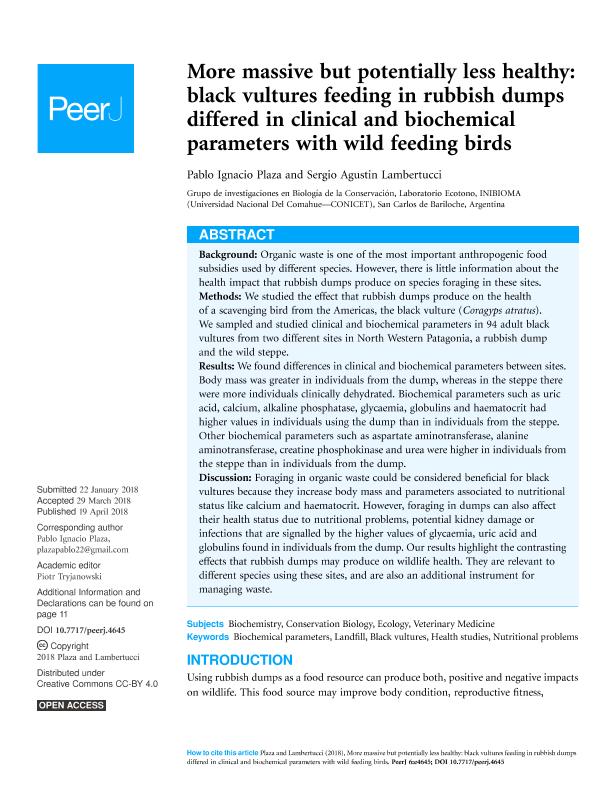Mostrar el registro sencillo del ítem
dc.contributor.author
Plaza, Pablo

dc.contributor.author
Lambertucci, Sergio Agustin

dc.date.available
2019-12-02T17:42:56Z
dc.date.issued
2018-04
dc.identifier.citation
Plaza, Pablo; Lambertucci, Sergio Agustin; More massive but potentially less healthy: Black vultures feeding in rubbish dumps differed in clinical and biochemical parameters with wild feeding birds; PeerJ Inc.; PeerJ; 2018; 4; 4-2018; 1-15
dc.identifier.issn
2167-8359
dc.identifier.uri
http://hdl.handle.net/11336/91091
dc.description.abstract
Background: Organic waste is one of the most important anthropogenic food subsidies used by different species. However, there is little information about the health impact that rubbish dumps produce on species foraging in these sites. Methods: We studied the effect that rubbish dumps produce on the health of a scavenging bird from the Americas, the black vulture (Coragyps atratus). We sampled and studied clinical and biochemical parameters in 94 adult black vultures from two different sites in North Western Patagonia, a rubbish dump and the wild steppe. Results: We found differences in clinical and biochemical parameters between sites. Body mass was greater in individuals from the dump, whereas in the steppe there were more individuals clinically dehydrated. Biochemical parameters such as uric acid, calcium, alkaline phosphatase, glycaemia, globulins and haematocrit had higher values in individuals using the dump than in individuals from the steppe. Other biochemical parameters such as aspartate aminotransferase, alanine aminotransferase, creatine phosphokinase and urea were higher in individuals from the steppe than in individuals from the dump. Discussion: Foraging in organic waste could be considered beneficial for black vultures because they increase body mass and parameters associated to nutritional status like calcium and haematocrit. However, foraging in dumps can also affect their health status due to nutritional problems, potential kidney damage or infections that are signalled by the higher values of glycaemia, uric acid and globulins found in individuals from the dump. Our results highlight the contrasting effects that rubbish dumps may produce on wildlife health. They are relevant to different species using these sites, and are also an additional instrument for managing waste.
dc.format
application/pdf
dc.language.iso
eng
dc.publisher
PeerJ Inc.
dc.rights
info:eu-repo/semantics/openAccess
dc.rights.uri
https://creativecommons.org/licenses/by/2.5/ar/
dc.subject
BIOCHEMICAL PARAMETERS
dc.subject
BLACK VULTURES
dc.subject
HEALTH STUDIES
dc.subject
LANDFILL
dc.subject
NUTRITIONAL PROBLEMS
dc.subject.classification
Zoología, Ornitología, Entomología, Etología

dc.subject.classification
Ciencias Biológicas

dc.subject.classification
CIENCIAS NATURALES Y EXACTAS

dc.title
More massive but potentially less healthy: Black vultures feeding in rubbish dumps differed in clinical and biochemical parameters with wild feeding birds
dc.type
info:eu-repo/semantics/article
dc.type
info:ar-repo/semantics/artículo
dc.type
info:eu-repo/semantics/publishedVersion
dc.date.updated
2019-10-10T13:53:55Z
dc.journal.volume
2018
dc.journal.number
4
dc.journal.pagination
1-15
dc.journal.pais
Estados Unidos

dc.journal.ciudad
Nueva York
dc.description.fil
Fil: Plaza, Pablo. Consejo Nacional de Investigaciones Científicas y Técnicas. Centro Científico Tecnológico Conicet - Patagonia Norte. Instituto de Investigaciones en Biodiversidad y Medioambiente. Universidad Nacional del Comahue. Centro Regional Universidad Bariloche. Instituto de Investigaciones en Biodiversidad y Medioambiente; Argentina. Universidad Nacional del Comahue. Centro Regional Universitario Bariloche. Laboratorio de Ecotono; Argentina
dc.description.fil
Fil: Lambertucci, Sergio Agustin. Consejo Nacional de Investigaciones Científicas y Técnicas. Centro Científico Tecnológico Conicet - Patagonia Norte. Instituto de Investigaciones en Biodiversidad y Medioambiente. Universidad Nacional del Comahue. Centro Regional Universidad Bariloche. Instituto de Investigaciones en Biodiversidad y Medioambiente; Argentina. Universidad Nacional del Comahue. Centro Regional Universitario Bariloche. Laboratorio de Ecotono; Argentina
dc.journal.title
PeerJ
dc.relation.alternativeid
info:eu-repo/semantics/altIdentifier/url/https://peerj.com/articles/4645/
dc.relation.alternativeid
info:eu-repo/semantics/altIdentifier/doi/http://dx.doi.org/10.7717/peerj.4645
Archivos asociados
